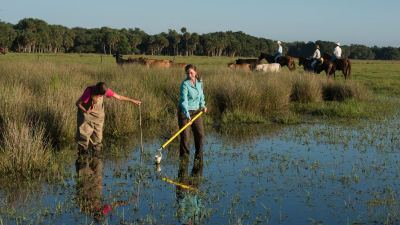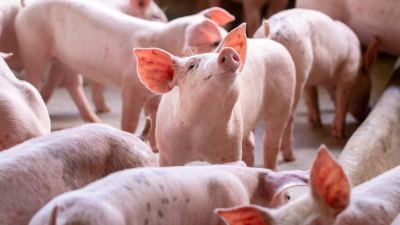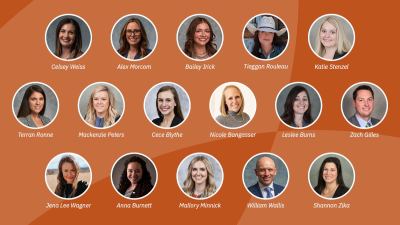Jim Akers – Rebuilding a Prominent Cattle Stockyard

Jim Akers has seen opportunity rise out of the ashes at the Blue Grass Stockyards in Lexington, KY.
In January 2016, a massive fire burned down Kentucky’s largest individual cattle market, the Blue Grass Stockyards. The stockyard has since rebuilt its facilities, but like many in the agri-food industry, it has faced new challenges over the past year. We spoke with COO Jim Akers about the current state of the meatpacking industry, the challenges and opportunities for rebuilding the cattle market and more.
The following is an edited transcript of the Ag Future podcast episode with Jim Akers hosted by Tom Martin. Click below to hear the full audio or listen on Apple Podcasts or Spotify.
Tom: In January 2016, a huge column of black smoke rose over Lexington, Kentucky. It could be seen as far away as Louisville, 70 miles to the west. A massive fire had broken out at Bluegrass Stockyards’ main Lexington facility, devastating the largest individual cattle market in Kentucky. To put it in perspective, Bluegrass Stockyards is to cattle what Keeneland is to Thoroughbreds. It’s been five years since the fire, and much has happened in that time. Joining us from Lexington is Bluegrass Stockyards CEO Jim Akers. Thanks for joining us, Jim.
Jim: Glad to be with you.
Tom: So, you all had a new 232,000-square-foot facility up and running on Iron Works Pike near the Kentucky Horse Park outside of Lexington just a year and a half after the fire. How did you manage to do business during the time before you could reopen?
Jim: Well, we were very fortunate in our structure in that we have two other facilities that are located within 35 miles of Lexington here, and we very quickly — in fact, by Monday morning after the fire that actually happened on Saturday, we had added sale dates at our Richmond and Mount Sterling locations and basically moved. We moved our Monday sale to Mount Sterling (and) our Tuesday sale to Richmond. We relocated some of our key employees, and customers listened to us, listened to our field people. And we picked right up and went on. Granted, customers had to travel a little farther, and (there were) certainly a little more logistical issues for us, but you know, it helped us maintain our business and our customer base.
Tom: Was the new location on Iron Works Pike already on your radar, or did you have to scramble in the aftermath of that fire to find a new spot?
Jim: Well, we actually already owned the property. Approximately 10 to 15 years prior to the fire, there was an effort to move the stockyard out of downtown Lexington, and this was one of the potential locations for that. So, we didn't have to acquire property, but there also were no real plans in place for the construction either.
Tom: I think we should emphasize for our listeners that it's been determined that the fire was an accident at the old facility, and that facility had been there for a lot of years and was wood. Correct?
Jim: Yes. Yes. Predominately, yes.
Tom: Right. So now, five years later, Bluegrass Stockyards is facing another challenge: the COVID-19 pandemic. Back in March, just as we were beginning to comprehend what a pandemic meant, the industry saw a rapid drop in the value of an animal — and at a critical time for local producers. Tell us what that period was like for the stockyard business.
Jim: Well, very complicated, Tom, from early April on up through, really, (the) middle part of the year, where you had multiple factors at play. Just the comfort level of people coming out to do business and, you know, coming into a facility — you know, that comfort level was pretty shaky. The market itself was extremely volatile. You know, we saw exorbitant prices at the grocery store, yet just a horrible market for the animals themselves on the farmer side. And so, it really caused a lot of people to hold cattle much, much longer than they would have. Our volume through the months of April, May and June (was) considerably below a normal year. We’re in a pretty significant liquidation phase in the cattle industry right now anyway. So, we were already hurting for numbers, compounded by the fact that people were hanging on to them, hoping that the market was going to get better. It was a pretty tough stretch.
Tom: You mentioned that people were kind of reluctant to gather, and now, it’s been many months since then. Has that kind of sorted itself out as people have become accustomed to masking and all that?
Jim: Yeah. Our level of compliance is far greater today than it was when we first started. We put a lot of measures in place literally right out of the gate because we were told by the Department of Agriculture and others that, you know, we have to continue to operate. We’re the only source of ready cash that a lot of these farmers have got. So, we had to try to keep running. And we started out by limiting the number of people that were allowed inside the sales arena. I actually had to post people at the doors to count heads in and heads out and try to keep that number down very low, and it was predominately just buyers at that point. We would let consignors in one or two at a time to watch their cattle sale. So, it was really a burden.
As we've moved along and understand a little more about social distancing, masking and all those kinds of things, we provide masks at the door to all our customers if they need them. We've actually eliminated about 2/3 — well, more than 2/3; almost ¾ — of our seating in the arena by blocking off those seats, enforcing social distancing. You know, people are, for the most part, fairly compliant with that. It's gotten better as we've gone along, certainly.
Tom: Well, you literally had opportunity rise out of the ashes in that this was an opportunity, out on Iron Works Pike, to start from scratch, to build an entirely new facility. And I'm just wondering how it differs from the original site. It might seem obvious, but maybe you can tell us more.
Jim: Well, you know, (I’ll) talk about the stockyard operation first. You know, having an opportunity to start from scratch with a clean slate and design a facility just like you'd like to have it was something that was pretty special. And so, obviously, the stockyard facility itself is far more efficient. It takes fewer people to operate. The movement of the cattle is quicker, safer and easier than it was in the old facility. Our ability to address workplace safety issues (and) cattle safety issues has certainly been far, far better in the new facility than we could ever do in the old one.
Relative to the rest of the operation out here, we've got what we call the Bluegrass regional marketplace; that's kind of the front end of the operation, the front building you come into on your way to the sales arena. That includes retail partners, a full-scale restaurant, a classroom with a certified teacher (and) museum content. And we've got about 15 to 20 other businesses that are located out here with us that are all agriculturally related (and) really create an interesting mix of goods and services that are all in one place.
Tom: So, who came up with that idea, to try to integrate retail — and events as well, correct?
Jim: Oh, you bet. You bet. Events are a big part of what we do. Meetings of all sizes, as well as several events that we put on ourselves throughout the year to educate the public, just create recreational opportunities and also drive business to these partners that we've got out here. You know, it was born out of a dream of the chairman of our board, Gene Barber. He talked for years and years and years about having kind of a one-stop shop for farmers where they could source their — buy their insurance, do their banking, all of those kinds of things, all in one location. As we got into this, the realities of the zoning and the type of building we could put up really didn’t allow us to exactly bring his dream to fruition, but out of that came this large building with multiple partners in many, many different aspects of the agricultural industry.
Tom: Well, Jim, some in the industry have been predicting that the influx of government money from pandemic-related programs — such as coronavirus (and) food assistance, the paycheck protection, the PPP and market facilitation programs like those — will have a lasting negative effect. Do you agree with that?
Jim: Well, you know, I don’t know about a lasting negative (impact). Farmers are farmers. You put dollars in their hands, they’re going to reinvest them, and they’ve done that with the CFAT money and the other monies that have been out there. We’ve seen — our market for high-quality replacement animals has certainly been really, really good here through the latter part of 2020 and the end of the early part of 2021. And I think that’s a reflection of that extra money that’s there in circulation.
You know, the reality of it is (that) this has been an extremely depressed market for the last couple (or) three years, and that shot in the arm has probably kept some people in business that might well not have survived through this. And even with that said, we’ve dispersed a lot of cowherds during this period of time. A lot. And we’ve decreased this cowherd considerably here, in the state of Kentucky, and surrounding states as well, but I don’t think you’re going to see a lasting impact. You know, the culture of the cattle producer is not one of government dependence. And so, I think this one or two influxes of extra money are probably just going to help people improve their operations, improve their overall economic stability and, hopefully, keep them in business.
Tom: Let’s turn to meatpacking. There are just four major operations in the country, and I’m wondering if the meatpacking industry needs some diversification. What’s your opinion on that?
Jim: Huge topic in the industry right now. And yeah, there’s no question: we have both the transparency issue in our fat cattle markets and a competition issue in our fat cattle markets. You know, when you’ve got four major packers in the United States that control 80-some percent of the slaughter capacity — (and) two of those entities are foreign-owned, which further compounds the issue. And we certainly have some problems at the upper end of the production system in that meatpacking sector. And you know, more than 80% of the cattle that are going into packing plants today or are not being sourced through any system of open price discovery — they're under contract or, you know, other arrangements with feedlots, where those prices are set on those cattle outside of the open marketplace. Well, it trickles back down through the entire industry, because those packers are one of the few segments of any business that I know of that not only gets to set the price for their product going out the door, but they also get to set the price for their inputs coming in the door. It’s a pretty good spot to be in.
Tom: What about the rise in recent years of competitive and alternative proteins? What do you feel the beef business needs to do to stay competitive with that?
Jim: You know, one of the things that we saw during COVID, if you watched when the grocery store started emptying out: what emptied out first? You know, the meat cases were empty on the first day. (There were) a lot of pictures floating around of, you know, the meat case empty, and then the alternative products are never out of stock.
We have a great product. We have a product that's in great demand, both domestically and in the export markets. I think we have to continue to improve our product and improve the perception of our production process in the eyes of our consumer. We can’t ever take our eye off that ball. We’ve got to continue to make steady progress moving forward of elevating not only the quality of the product itself but the perception of that product — nutritionally, animal husbandry, all of those factors come into play.
You know, those alternative products are certainly a concern of a lot of people here in the meat industry. Personally, I think they’re somewhat of a niche market — maybe a large niche market for a growing population of people that don’t want to eat meat, for one reason or another. But at our current level of production, boy, it’s sure not been difficult to move this product. So, we certainly have demand. I think we just need to be cognizant of the fact that there is competition out there and continue to do the best we can to put a better product in front of our consumer.
Tom: Well, Jim, as somebody who’s been around the cattle business for a long time, what would you say has changed the most and why?
Jim: Because of what we’ve just talked about, you’re seeing more and more of the marketplace driven by data and information. It’s become more difficult for the smaller producers to participate in the marketplace. And subsequently, we’ve lost a lot of our smaller producers that were selling not necessarily a bad product but more of a commodity product into the system, (and) that was a big part of our business over the years in the livestock markets. And we’ve certainly had to adjust to make our sales relevant to those larger and larger producers that are more data-driven and more information-driven and provide value to them in our system. But you know, we typically are gravitating toward dealing with ever larger producers that are handling more and more cattle across the broader geographies and doing it with a lot more technology.
Tom: So, Jim, how long have you actually been in the cattle business?
Jim: I mean, I’m 56 years old, and I've basically been in the industry in one form or another all of my life.
Tom: Well, I’m just wondering: Any favorite memories from your time in the business? It's a lifelong thing, I know, but anything stand out there? The fire certainly isn’t one of them.
Jim: No. The fire is not. It is certainly a memory, but it's not a good memory.
Tom: Right. Right.
Jim: You know, as I look back over the years, you do have to love this business. If you didn't, you couldn't survive. Facing a lot of challenges along the way and surviving those challenges and going on to grow and be better, (and) the many, many just amazing people that are in this great industry — too oftentimes, we get hung up on a handful of bad guys out there, but the vast majority of the people that we deal with are just tremendous, salt-of-the-earth, honest people (who) are really dedicated to putting a good product in front of our consumers and doing good business. And I guess that’s probably the best memory for me, is just getting to know and dealing with all of those really fine folks.
Tom: All right. That’s Bluegrass Stockyard CEO Jim Akers. Jim, thanks so much for joining us.
Jim: You bet. Thank you.
Tom: And I'm Tom Martin, and thanks for listening to us.
Announcer: Join us for the rest of this series as we reflect on how the agriculture industry adapted in 2020 and speak with experts on what's in store for agri-food in 2021. Thank you for joining us. Be sure to subscribe Ag Future wherever you listen to podcasts.















